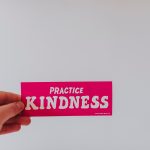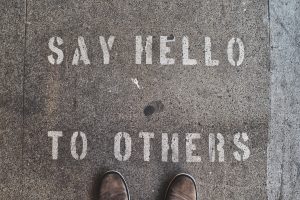What place should kindness have at work?

I’ve been thinking about kindness at work a lot lately. It seems to be a lost art in our current world. Reviewing the blog articles that I have written this year, I have two favorites, and they are both about kindness.
One article ‘Four workplace lessons from the Great British Baking Show’ highlights the ability of the show to balance competitiveness with kindness between contestants.
The second article ‘An afternoon with Marshall Goldsmith and the Doerr Institute for New Leaders’ shares the joy and kindness that Marshall Goldsmith brings to his work and his willingness to freely spread his knowledge for a compounding effect.
Defining kindness

Kindness is not weakness. Recognizing the connections that we have and need as human beings increases our strength.
Kindness does not replace the need to get things done and run profitable businesses, but maybe it changes how we approach those. Maybe we need a reminder to balance bottom-line financial decisions with kindness.
Researchers define kindness as an act that enhances the welfare of others as an end in itself.
Kindness comes in any forms – such as doing a favor, giving someone the benefit of the doubt, giving to charity, speaking gently to someone and even having kind thoughts.
Studying Kindness
One awesome side effect is that kindness also benefits the giver.
Kindness is finally getting some positive press. In September 2019, The Los Angeles Times published a story by Teresa Watanabe called ‘New UCLA institute will study – and spread – kindness’.
She covers the launch of a new interdisciplinary research institute at UCLA, The Bedari Kindness Institute, to study kindness. They seek understanding of how kindness reduces physical illnesses like depression and cancer and cardiovascular disease.
Melissa Broderick published a discussion of kindness on the Harvard Health Blog called the ‘Heart and Science of Kindness’. She talks about the importance of being kind to yourself as well as others and of practicing kindness.
Link to positive psychology
Positive Psychology incorporates kindness into many of its approaches. This article at Positive Psychology.com called ‘What is kindness in psychology?” covers kindness from a positive psychology perspective. It provides some research information and links to many additional resources such as TED Talks, books and kindness challenges.
Link to the Magnify Impact Coaching (MIC) Model

The Magnify Impact Coaching (MIC) model defines my approach to leadership development for senior leaders.
MIC focuses on senior leaders and coachable behaviors. I thought long and hard about whether or not kindness belonged in the model.
Is kindness a fundamental trait that must already be in place? Is it teachable?
Kindness has both behavioral and thought components. But people can learn to be more kind and behave with kindness, so it became part of the MIC model.
Navigating politics should encompass kindness
I categorize kindness as part of competency #6 of MIC – Navigate Politics. Navigate Politics includes influencing others and managing relationships to get work done.
Kindness must balance potentially negative side of manipulative politics. Senior leaders often rise to power through competitiveness and achievement, which can sometimes leave kindness behind.
Some leaders would benefit from a reminder about kindness and how it can be a strength in the workplace.
Kindness: loaning someone your strength instead of reminding them of their weakness.
What kindness is NOT
Kindness does not mean to stop enforcing rules or holding people to deadlines and deliverables. Work must get done – it is the reason you are there.
Kindness does not mean weakness. You can still act assertively, take charge when appropriate and drive for results.
Also, don’t confuse kindness with giving other people a pass for bad behavior. Sometimes holding someone accountable or even firing an employee who is not a good fit for a job can be an act of kindness.
5 tips for more kindness at work
To bring more kindness to work without compromising outcomes, consider these 5 tips.

- Display common courtesy. Remember common courtesy. Say hello to people – even strangers – in the hallway. Check your emails to make sure they don’t sound too abrupt. Apologize if you bump into someone. You know these basics – remember to do them!
- Re-frame hierarchy. Leaders can get caught up in hierarchy. In most companies, hierarchy still pays an important role. Some people set direction and others execute. Hierarchy exists at work, but remember, work hierarchy does not cover all aspects of life. The people in your reporting relationship at work might be peers at your place of worship or a fellow parent at the local school or a neighbor. People are more than their role at work, so treat them as you would a neighbor or external colleague.
- Assume positive intent. if you are frustrated with someone, start by assuming that they have positive intent to accomplish your goal. From that perspective, you might discover a misunderstanding or a different approach. Assuming positive intent gives you a neutral platform for resolving a dispute.
- Pause before speaking. If you find yourself angry, pause for a few seconds before responding. The pause provides a chance to calm down and consider the words and tone that you want to use. A simple pause – and maybe a deep breath or two – can stop a negative spiral in an interaction.
- Be less judgmental. Try to catch yourself being judgmental about someone’s appearance or style or accent. Accept each person as they are and kindness will flow more naturally.
How can you bring more kindness to your workplace?



